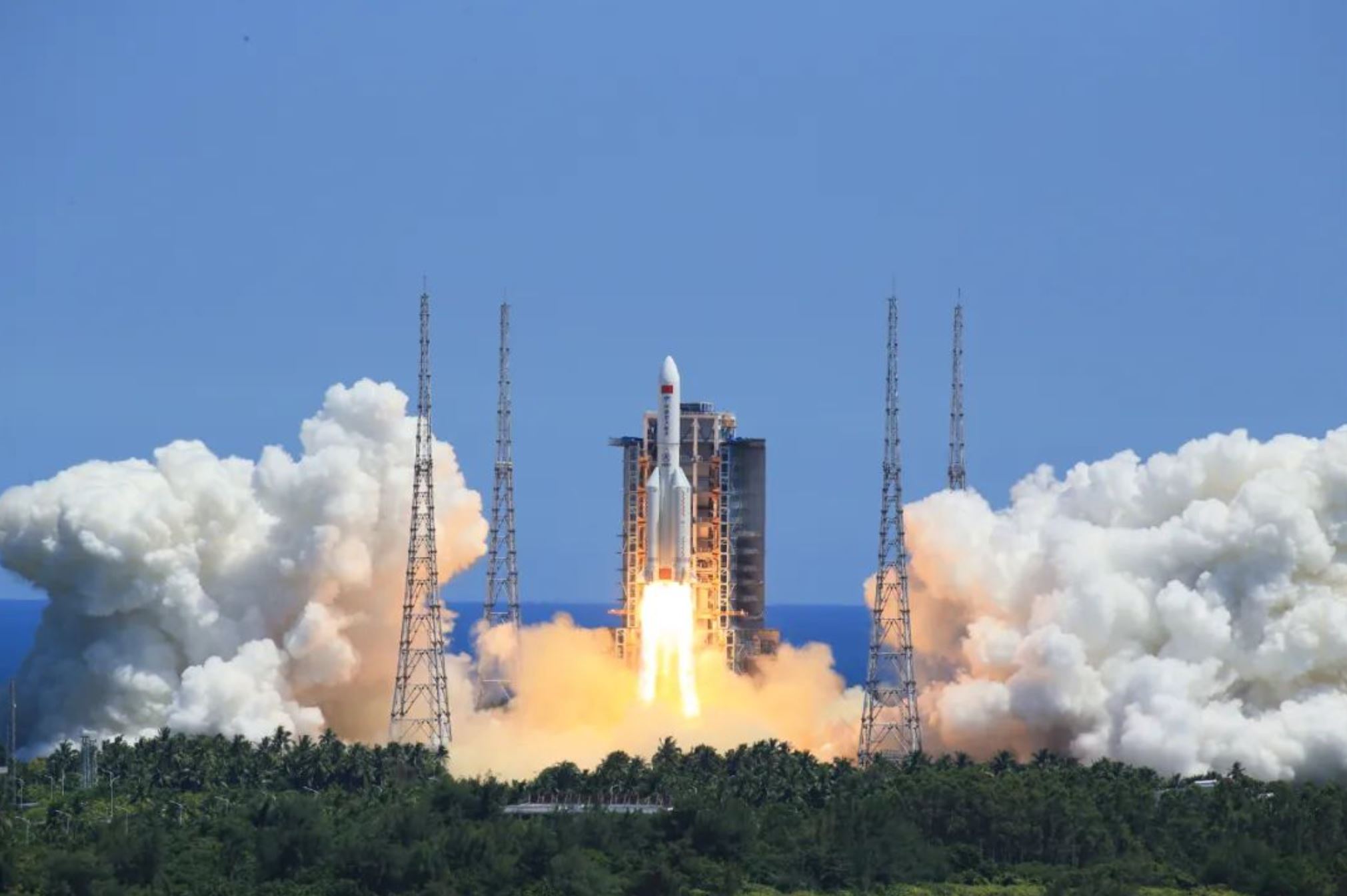HELSINKI — China added a new experiment module to its space station Sunday, following a high-profile launch from the country’s coastal spaceport.
The Wentian experiment module launched atop of a Long March 5B rocket at 2:22 a.m. Eastern from the Wenchang spaceport on the southern Chinese island of Hainan, with crowds watching on from nearby public beach areas.
Wentian used its own propulsion system to match orbit with Tianhe, the core module of China’s under-construction space station, and completed rendezvous and docking with a forward docking port at 3:13 p.m. Eastern, July 24, China’s human spaceflight agency confirmed.
The Wentian module had a mass at takeoff of 23,000 kilograms and is designed to host a range of science cabinets for on-orbit experiments. It also provides backup life support and propulsion for Tianhe, which launched in April 2021, and provides new working and living quarters and an EVA hatch for astronauts.
“This should be a historic moment. China’s largest carrying rocket today successfully launched the heaviest, longest and arguably the most important craft in the country’s space history. The mission was well fulfilled, which is very exciting and exhilarating,” Li Dong, chief designer of the third March 5B rocket told China Central Television.
The country has now successfully launched eight space station-related missions for the project, including two modules, three cargo spacecraft and three crewed missions. A third module, named Mengtian, is expected to launch around October.
Both Wentian and Mengtian will be transpositioned to lateral docking ports, completing the planned T-shaped Tiangong space station. China intends to operate the station for at least a decade, with crews of three astronauts six-month-missions.
“There are mainly the experimental cabinets of life ecology and biotechnology,” Zhao Liping, chief designer of the module, told Chinese state media CGTN. “There are also glove boxes for astronauts to handle samples in orbit, as well as refrigerators with temperatures of minus 80 degrees Celsius, minus 20 degrees Celsius and four degrees Celsius, which will store samples after completing the in-orbit experiments.”
Rocket stage reentry
While the launch and docking were successful, attention will also now be on the fate of the large first stage of the Long March 5B rocket, which entered orbit along with Wentian.
U.S. Space Command cataloged two objects in orbit following launch of Wentian, indicating that the large first stage was not actively deorbited following launch.
Two objects cataloged from the CZ-5B launch: 53239 / 2022-085A in a 166 x 318 km x 41.4 deg orbit, 53240 / 2022-085B in a 182 x 299 km x 41.4 deg orbit. Orbital epoch of ~1200 UTC confirms that the inert 21t rocket core stage remains in orbit and was not actively deorbited.
— Jonathan McDowell (@planet4589) July 24, 2022
The two previous Long March 5B launches, which carried a test new generation crew spacecraft prototype and the Tianhe module respectively, notably saw the large first stage of the rocket enter orbit and make uncontrolled reentries.
The rocket stage from the Tianhe launch reentered the atmosphere over the Indian Ocean 10 days after launch. If not actively deorbited, the latest Long March 5B stage will reenter the atmosphere between 41 degrees north and 41 degrees south due to atmospheric drag
Where and when the roughly 21-metric-ton empty will reenter cannot be accurately estimated. The stage will orbit the Earth once every 90 minutes, with the decay of its orbit dependent on atmospheric fluctuations. Variables including solar activity, which can puff up the atmosphere, leading to greater drag at higher altitudes.
“Although the amount of debris that survives reentry isn’t simply a function of stage mass, it’s nevertheless true that a 21 tonne stage poses a much bigger risk than a typical 1 to 5 tonne upper stage, as the 2020 Ivory Coast incident makes clear,” astronomer and spaceflight analyst Jonathan McDowell told SpaceNews.
“So, I congratulate China on the successful launch of Wentian but deplore their failure to redesign the Long March 5B that sets us up for another major uncontrolled reentry.”
The first stage of a rocket for an orbital launch cuts its engines off before reaching orbital velocity, falling within a calculated, safe area. Smaller second or further stages do the final work to carry a spacecraft into orbit. In the case of the Long March 5B, the large first stage is also the upper stage.
Chinese foreign ministry spokesperson Wang Wenbin stated last year that it was “common practice across the world for upper stages of rockets to burn up while reentering the atmosphere.”
Last year’s Long March 5B uncontrolled reentry led to indirect exchanges of commentary from NASA Administrator Bill Nelson and China’s Foreign Ministry spokespersons.
The China Academy of Launch Vehicle Technology (CALT), the maker of the Long March 5B, did not comment on the previous incidents. It has however stated that it carries out passivation of spent stages, including venting remaining propellant depleting batteries, to prevent debris-causing explosions in orbit in line with international practices.
The wider issue of uncontrolled rocket body reentries is assessed in a Nature Astronomy paper published July 11. It estimates that, with current practices, there is a 10 percent chance of uncontrolled reentries causing one or more casualties over a decade.
